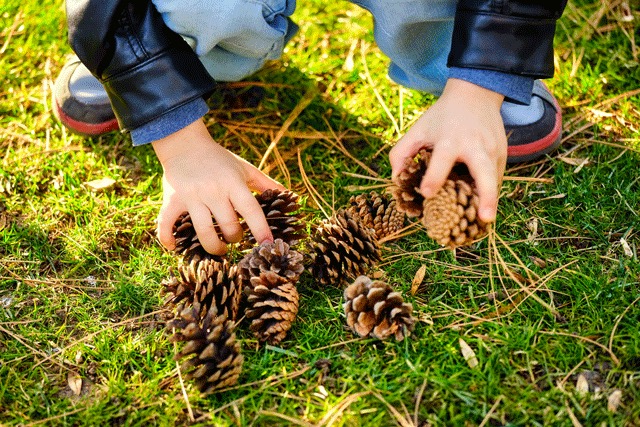
When I was a teacher of young children, I especially loved setting out materials in the art center. I would admire the colors and textures of the materials while pouring cups of paint and glue and filling little baskets with drawing and collage materials. I wondered how the children might explore and use the materials. I enjoyed setting up interesting ways to make art, such as painting with spoons, golf balls, or lengths of yarn.
One vivid memory is from teaching 2-year-olds. After trying to use pine needles instead of brushes, the children and I wondered about other natural items we could use for painting. We tried pinecones, sticks, and even the fascinating fruit of an Osage orange tree near our playground.
The children had noticed the large, bumpy green fruits falling from the orange tree. They were very curious to investigate these fruits. Together, we explored their shape, scent, and texture. We rolled them in tempera paint and delightfully discovered they left a beautiful pattern on the paper. What started as a painting activity ended up providing the children a chance to explore math and science concepts while building their language abilities.
Our conversation about where these mysterious fruits had come from led to conversations about the growth of trees. We talked about how the fruits grew from flowers and increased in size over the summer until they were heavy and fell from the trees. We talked about the weight, shape, and size of the fruits. We watched the squirrels nibbling the fruits, and that inspired us to look inside the fruits.
Children gained vocabulary related to trees and texture (e.g., skin, seed, bumpy, waxy). They practiced their hand-eye coordination and dexterity as they explored the materials. If we pause and reflect, we can see how powerful this type of activity can be in promoting learning because we refocused our attention on the “process” of creation rather than what was created.
High-quality visual art experiences for young children should emphasize the process of creating. However, the art created by these “process art” experiences usually lack easily identifiable images. Because of this challenge, adults guiding young children may be tempted to plan “crafty” art activities that lead to an identifiable product to avoid this challenge.
Therefore, our classroom team had to help families and other adults in the center understand how the painting experience supported the children’s development and promoted their learning. We included photos and a short explanation of the activity with our display of the paintings. When the children looked at the display, they were eager to point out how the bumpy hedge apples had created circular trails of paint as they rolled them on the paper. We wrote down their words and included them as part of our documentation display so people looking at the artwork could have insight into the children’s creative experience.
Recently, I worked with a group of Head Start teachers and family advocates in a workshop in which we experimented with crayons, different types of papers, and textured materials. I encouraged them to make crayon rubbings of bubble wrap, cross-stich canvas, and bumpy cardboard. We also experimented with drawing on bumpy paper, sandpaper, and slick aluminum foil.
The room was quiet while everyone focused on their experimentation. I heard a few people ask, “Why are we just coloring with crayons during a professional development day?” I assured them that this was part of the learning process.
Suddenly, a participant said in a frustrated tone: “This sandpaper is eating up my crayon!” We talked about how a child might make a similar observation. We realized that the art activity could easily become a science experiment with young children. Teachers brainstormed about trying different-sized crayons, trying different grades of sandpaper, and counting the number of strokes it might take for a crayon to be used up.
There were so many possibilities to explore with crayons and textures! We began to list other things to explore with texture, such as creating rubbings with chalk, dipping textured items in paint to make patterns, and pressing textured items into clay or play dough.
I think the art centers in these teachers’ classrooms will be busy this school year. Perhaps you and the children in your home or center may also make art a part of every day!


 Printer-friendly PDF
Printer-friendly PDF Rebecca Swartz
Rebecca Swartz
 Printer-friendly PDF
Printer-friendly PDF